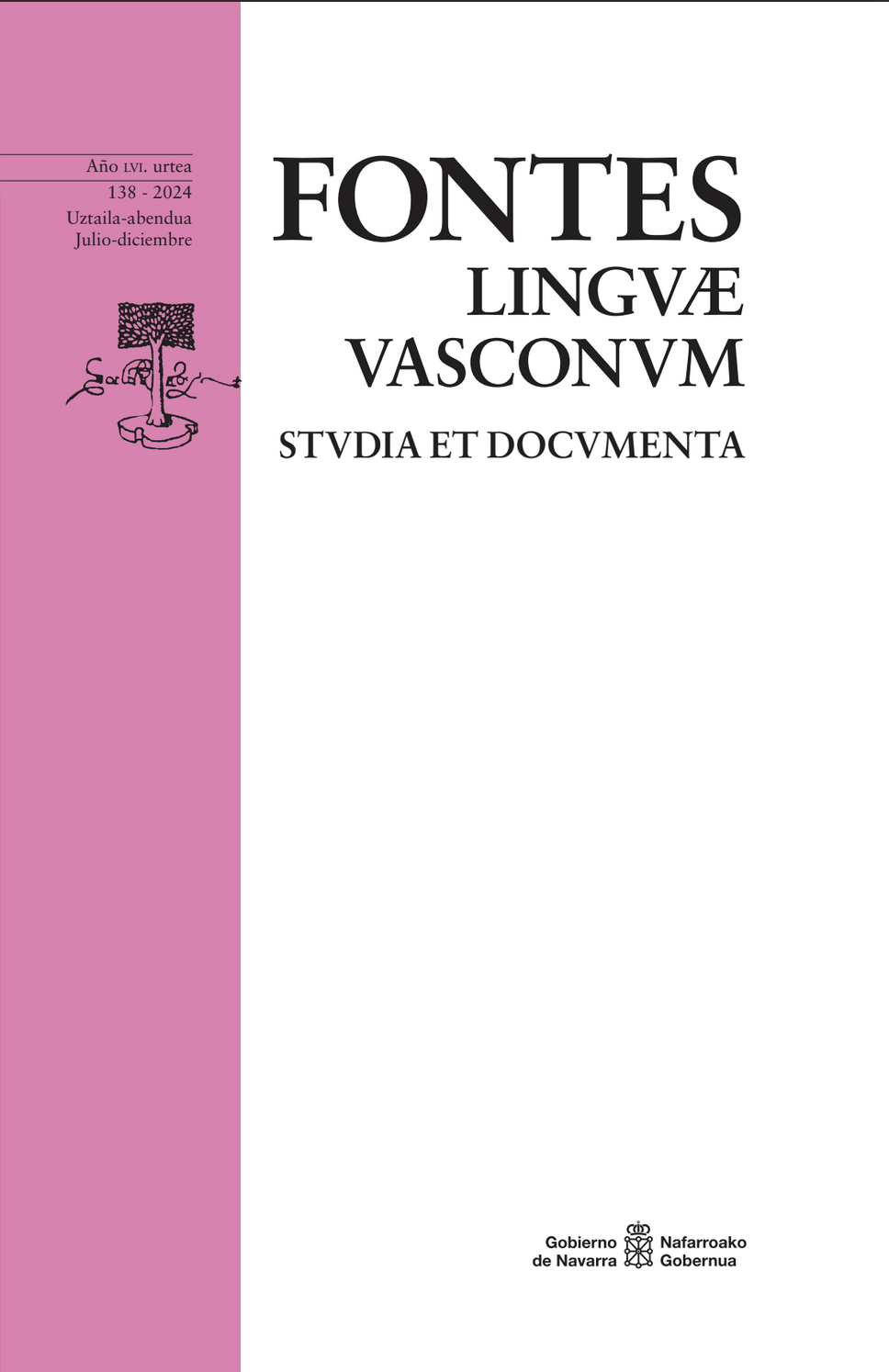Uxue Apaolazaren «Manoletinak» (Bihurguneko nasa) ipuineko ekfrasiez: irakurketa proposamen bat [Reading «Manoletinak» (Bihurguneko nasa, Uxue Apaolaza) based on the ekphrases]
Abstract
According to specialists, Uxue Apaolaza tends to underline the edges of the (un)speakable. Recent research into the concept of ekphrasis suggests that this means ethics and grammar of the gaze, as a reflection or translation of the (in)visible. Thus, the aim is to analyse the short story «Manoletinak» (Bihurguneko nasa, 2023, Euskadi Prize) taking as its axis, precisely, the painting by Maia Plisetskaya that is mentioned in the story. The ekphrases of Plisetskaya’s image are probably more significant than they might seem and their analysis will reveal new readings of their own at the heart of the story. To this end, studies of ekphrasis, gender studies, and reception theory will be combined.
##about.statistics##
References
Apaolaza, U. (2021). Bihurguneko nasa. Susa. https://www.susa-literatura.eus/liburuak/narr139
Arrese, G. (2021, azaroak 6). Hamarkada batez Madrilen. Berria. https://www.berria.eus/kultura/hamarkada-batez-madrilen_1303828_102.html
Artigas, I. (2013). Galería de palabras. La variedad de la ecfrasis. Iberoamericana.
Atxaga, B. (2020, azaroak 26). Pange lingua, voglio una pizza. La conversa entre Bernardo Atxaga i Izaskun Arretxe [Bideoa]. Youtube. https://www.youtube.com/watch?v=DRrxo9ix6fo
Brosch, R. (2018). Ekphrasis in the digital age: Responses to the image. Poetics Today, 39(2), 225.-243. or. https://doi.org/10.1215/03335372-4324420
Chaviano, D. (2015, maiatzak 2). Maya Plisetskaya: Ha muerto el cisne. Blog de Daína Chaviano. https://blog.dainachaviano.com/2015/05/02/maya-plisetskaya-ha-muerto-el-cisne-2/
Clive, B. (1977a). The Ballet: Plisetskaya’s ‘Bolero’. The New York Times. https://www.nytimes.com/1977/03/28/archives/the-ballet-plisetskayas-bolero.html
Clive, B. (1977b). The particular genius of Maya Plisetskaya. https://www.nytimes.com/1977/04/03/archives/article-4-no-title-the-particular-genius-of-maya-plisetskaya-dance.html?searchResultPosition=2
Collins, S. (2019). Currently and emotion: activism and affect in contemporary poetry translation [Doktore-tesia, Queen’s University Belfast]. https://pure.qub.ac.uk/en/studentTheses/currently-and-emotion
Cruz, R. (2021). Ecfrasis. In S. Gónzalez, R. Cruz & M. García (arg.). Vocabulario crítico para los estudios intermediales. Universidad Nacional Autónoma de México.
Currás, P. (2022). “Objects can be unintentionally beautiful”: Feminist ekphrasis and object-orientation in the poetry of Mary Jo Bang and Bernadette Mayer. ATLANTIS. Journal of the Spanish Association of Anglo-American Studies, 44(1), 92-112. https://doi.org/10.28914/Atlantis-2022-44.1.06
Dolores, J. (2020). Massa diva per un moviment assambleari. https://teatrounam.com.mx/teatro/fitu30/juana-dolores-massa-diva-per-a-un-moviment-assembleari/
Dolores, J. (2022). Hit me if I’m pretty. https://temporada-alta.com/es/shows/hit-me-if-im-pretty/
Egaña, I. (2019). Heridas que hablan: sujeto, género y trauma en la narrativa vasca. Journal of Catalan Studies, 21(1), 54-71. https://revista.anglo-catalan.org/ojs/index.php/jocs/article/view/30/30
Elsner, J. (2010). Art History as ekphrasis. Art History, 33(1), 10-27. https://doi.org/10.1111/j.1467-8365.2009.00720.x
Etxarte, H. (2023, urtarrilak 14). Polizia hemen hasten da. Berria. https://www.berria.eus/iritzia/larrepetit/polizia-hemen-hasten-da_1328686_102.html
Euskaltzaindia. (2016). Gramatika. In Euskaltzaindiaren hiztegia. https://www.euskaltzaindia.eus/index.php?&option=com_hiztegianbilatu&task=bilaketa&I-temid=1693&lang=eu&nondik=0&zenbat=100&entryId=20679
Euskaltzaindia. (2016). Etika. In Euskaltzaindiaren hiztegia. https://www.euskaltzaindia.eus/index.php?&option=com_hiztegianbilatu&task=bilaketa&Ite-mid=1693&lang=eu&nondik=0&zenbat=100&entryId=16638
Fernandez, N. (2020). Euskal ipuingintza garaikidea genero-politikaren argitan: maskulinitate eta feminitate ereduak aztergai [Master Amaierako Lana, UPV/EHU]. https://www.ehu.eus/documents/2007376/24096326/Euskal-ipuingintza-garaikidea-genero-politikaren-argitan.pdf/64a44224-81a5-f3e6-2512-d10f998aa3ae?t=1615541757997
Fernandez, N. (2021). Feminist agenda(k) Eider Rodriguezen Katu jendea eta Bihotz handiegia ipuin liburuetan. Egan: Literatura Aldizkaria, 74(1-2), 49-82. https://www.rsbap.org/ojs/index.php/egan/article/view/4601
Fernández, N. (2022, abenduak 5). Uxue Apaolaza y Fermin Etxegoien. Ventana a la literatura vasca [Bideoa]. Youtube. https://www.youtube.com/watch?v=x_Lx0O7FkQs
Fernandez, N. (2024). Ipuinek mila kontu. Ignacio Aldecoa [Bideoa]. Youtube. https://www.youtube.com/watch?app=desktop&v=-dJFaOtRf4s
Ferreira, M. (2023, apirilak 7). Uxue Apaolaza: “Vestimos de Zara para parecer ricos y seguimos siendo clase obrera”. El Diario. https://www.eldiario.es/euskadi/uxue-apaolaza-vestimos-zara-ricos-seguimos-clase-obrera_128_10093251.html
Genovart, A. (2023). Consumir preferentemente [itzul. R. Martín]. Anagrama. (Jatorrizko obra 2023an argitaratua).
González, S., Cruz, R. & García, M. (2021). Vocabulario crítico para los estudios intermediales. Hacia el estudio de las literaturas extendidas. Universidad Nacional Autónoma de México. https://ru.atheneadigital.filos.unam.mx/jspui/bitstream/FFYL_UNAM/5830/1/Vocabulario%20cri%CC%81tico%20para%20los%20estudios%20intermediales.pdf
Irujo, X. (2017). La verdad alternativa. 30 mentiras sobre el bombardeo de Gernika. Txertoa.
Iser, W. (1987). El acto de leer. Taurus. https://archive.org/details/ilide.info-iser-wolfgang-el-acto-de-leer-teoria-del-efecto-estetico
Iser, W. (1972). The reading process: A phenomenological approach. New Literary History, 3(2), 279-299.
Johnston, A.J., Knapp, E. & Rouse, M. (2015). Ekphrasis in Medieval Literature and Culture. The Ohio State University Press. https://doi.org/10.2307/j.ctv6zdcxv
Kortazar, J. (2009a). Arteen arteko elkarrizketa. In Askoren Artean. Juan Mari Lekuonari omenaldia (295.-312. or.). Euskaltzaindia.
Kortazar, J. (2009b). Jokin Zaitegiren poesia. ASJU, 43(1-2), 539-552. https://doi.org/10.1387/asju.1732
Majuelo, I. (2021, azaroak 21). Hurrengo bihurgunean zer topatuko. Berria. https://kritikak.armiarma.eus/?p=8443
Manterola, I. (2017). Maite ditut maite. Transmisioa XX. mendeko Euskal Herriko artean. Edo! https://armiarma.eus/edo/liburua-maite_ditut_maite
Martin, J. (2023). Género, raza y clase en la novela “Estación en curva” de Uxue Apaolaza. Femeris, 8(3), 97-112. https://doi.org/10.20318/femeris.2023.8150
Mitchell, W.J.T. (2005). There are no visual media. Journal of Visual Culture, 4(2), 257-266. https://doi.org/10.1177/1470412905054673
Panagiotidou, M.-E. (2022). The poetics of ekphrasis. A stylistic approach. Palgrave Macmillan. https://link-springer-com.ehu.idm.oclc.org/book/10.1007/978-3-031-11313-0
Proust, M. (2018). En busca del tiempo perdido 1. Por el camino de Swann [itzul. P. Salinas]. Alianza. (Jatorrizko obra 1913tik 1927ra, zazpi liburukitan, argitaratua)
Rodriguez, E. (2011). Hitzaurrea. In B. Gopegui (egilea), Tiroa kontzertuaren erdian. Eleberrietan politikaz aritzeari buruz. Txalaparta.
Román, A. (2024). Tiktok, escapismo y ¿la caída del feminismo? [Bideoa]. Youtube. https://www.youtube.com/watch?v=rMd41rJlceY
Ruiz Torraldo, M. (2016). Kartzela genero-erakunde bezala: genero-bereizkeriak, erresistentzia-praktikak eta agentzia Euskal Herrian espetxeratutako emakumeen artean [Doktore-tesia, UPV/EHU]. ADDI. https://addi.ehu.es/bitstream/handle/10810/15042/Discursos%20y%20pr%C3%A1cticas%20queer_Maria%20Ruiz%20Torrado.pdf;sequence=1
Saalbach, M. (1994). La literatura en versión cinematográfica: posibilidades y límites de la transposición. In F. Eguíluz, R. Merino, V. Olsen, E. Pajares & J.M. Santamaría (koor.), Transvases culturales: literatura, cine, traducción (417.-424. or.). UPV/EHU. http://hdl.handle.net/10810/10059
Sarasola, A. (2022, otsailak 19). «Anekdota batean ia beti daude arnasa sakonagoko zerbait egiteko zuntzak». Berria. https://www.berria.eus/kultura/anekdota-batean-ia-beti-daude-arnasa-sakonagoko-zerbait-egiteko-zuntzak_1309202_102.html
Sarrionandia, J. (2013). Hnuy illa Nyha Majah Yahoo. Elkar.
Urzaa, G. (2015). Ekfrasiaren eta abangoardiaren eragina Isturitzetik Tolosan barru poema-liburuan [Gradu Amaierako Lana, UPV/EHU]. ADDI. http://hdl.handle.net/10810/21245
Utrera, M. (2024, martxoak 13). Euskal ipuingintzaren ertzak aztertu dituzte adituek Gasteizen. Berria. https://www.berria.eus/kultura/euskal-ipuingintza-izan-dute-hizpide-aldekoa-jaialdiaren-lehen-egunean_2122226_102.html
Zeitlin, F. (2013). Figure: Ekphrasis. Greece and Rome, 60(1), 17-31. https://doi.org/10.1017/S0017383512000241
Copyright (c) 2024 Leire Iruretagoiena Goikoetxea

This work is licensed under a Creative Commons Attribution-NonCommercial 4.0 International License.







